Most towing operations offer their drivers a commission on top of their standard wages. Tracker offers an easy, and customizable, way to apply these commission rates.
If you have set up your account rates within Tracker, it is helpful to think of driver commission, as simply driver rates. You create the template for a given tow type, then you apply that rate to the driver in question.
Creating the Commission Templates
Much like with account rates, commission rates can be set up in the same way. This can be done by navigating to Lists -> Employees -> Driver Commission Rate, as seen below. If you find that you don't have access to the employees list, then this is due to the security permissions.

This option will open up a Rate List. From here, you can select the New button or click on a commission rate from the list to edit its contents.

Next, the Driver Commission Rate Code window will appear. This window is where you can customize every aspect of a driver's commission for a particular type of tow.
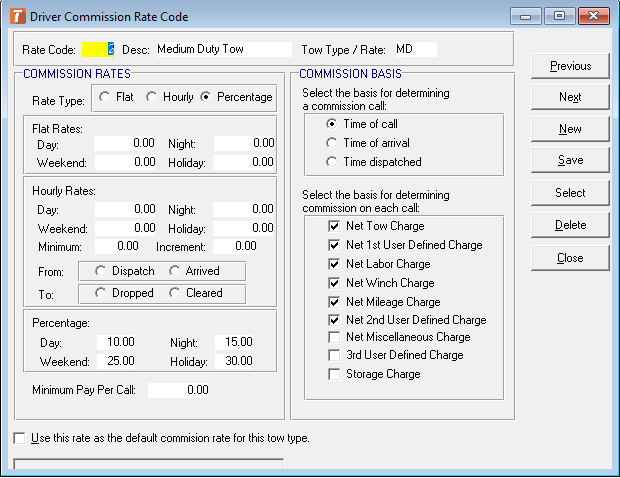
Just like with account rates, driver commission is based on which tow type they are currently using. So a driver's commission needs to be set for each tow type your towing operation provides. You can specify what tow type you are making a commission for by entering the short code for that tow type, as seen below within red. Be sure to assign a unique rate code for this commission, as seen below in black, to provide an easy way to refer to the commission during data entry. This rate code can be any four numbers.
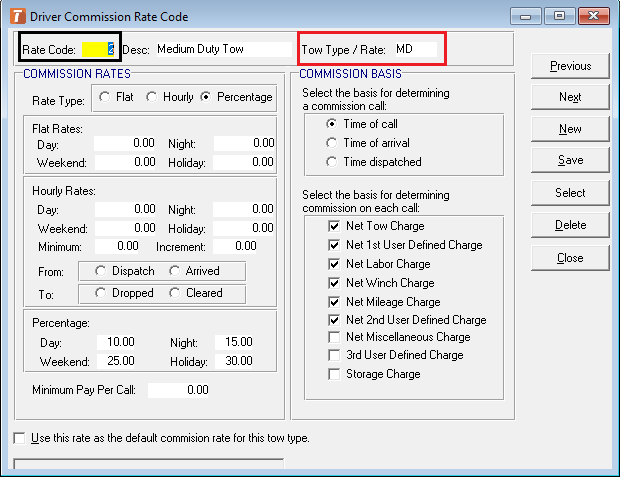
Commission Rates
A primary customization for commission is that you can choose what type of commission is paid to a driver, whether it is a flat, hourly, or a percentage of the tow. Be sure to select which type of commission you are using before specifying the finer details.

Flat - Choose this if you would like a static amount paid for every tow the driver does. Be sure to specify this flat amount for each time provided.
Hourly - Choose this if you would like the commission paid as an hourly rate. Be sure to specify the amount for each time provided, if there is a minimum amount, and what the increment is (in minutes). Then choose if the commission starts on dispatch, or arrival. Then choose if the commission ends when the vehicle is dropped, or when the ticket is cleared.
Percentage - Choose this if you would like the commission to be applied as a percentage of the net charges. Be sure to specify the percentage amounts for each time provided.
Hourly - Choose this if you would like the commission paid as an hourly rate. Be sure to specify the amount for each time provided, if there is a minimum amount, and what the increment is (in minutes). Then choose if the commission starts on dispatch, or arrival. Then choose if the commission ends when the vehicle is dropped, or when the ticket is cleared.
Percentage - Choose this if you would like the commission to be applied as a percentage of the net charges. Be sure to specify the percentage amounts for each time provided.
Commission Basis
The commission basis determines at what point in time a call is considered eligible for commission, as seen below in red. And the selectable charges, as seen below in blue, determine what charges on a ticket can have commission paid on.
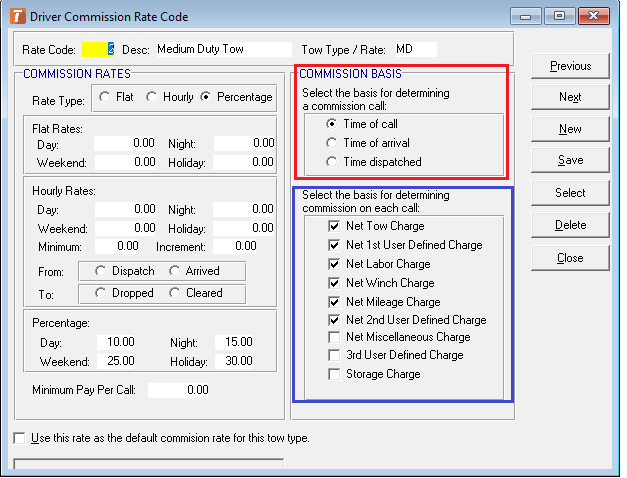
Once you have finished creating the commission rate for this tow type, remember to hit save.
Applying the Commission
After you have created a commission template for each of your tow types, it's time to apply them. Now this is the part where driver commission diverges from account rates. Where account rates need to be applied for each account, the application of applying rates is much more streamlined.
Once you have created each commission, you can apply it to all of your drivers by simply checking the box at the bottom of the Driver Commission Rate Code window, as seen below in red. This will make the current commission the default option for this tow type.

Setting Up Day, and Night Commission
Tracker does not, inherently, know when to switch the commission from day to night, and back again. That is why, within each driver's profile, you can specify what is considered the day hours, the night hours, and when the weekend starts for a particular driver. Do note that you need to use the 24 hour clock format, also known as military time, when entering this data.

Applying Driver Specific Commissions
If you need to have different commission rates for certain drivers, you can go into their employee profile (Lists -> Employees -> Employees), and select Commission Rates, as seen below in red.
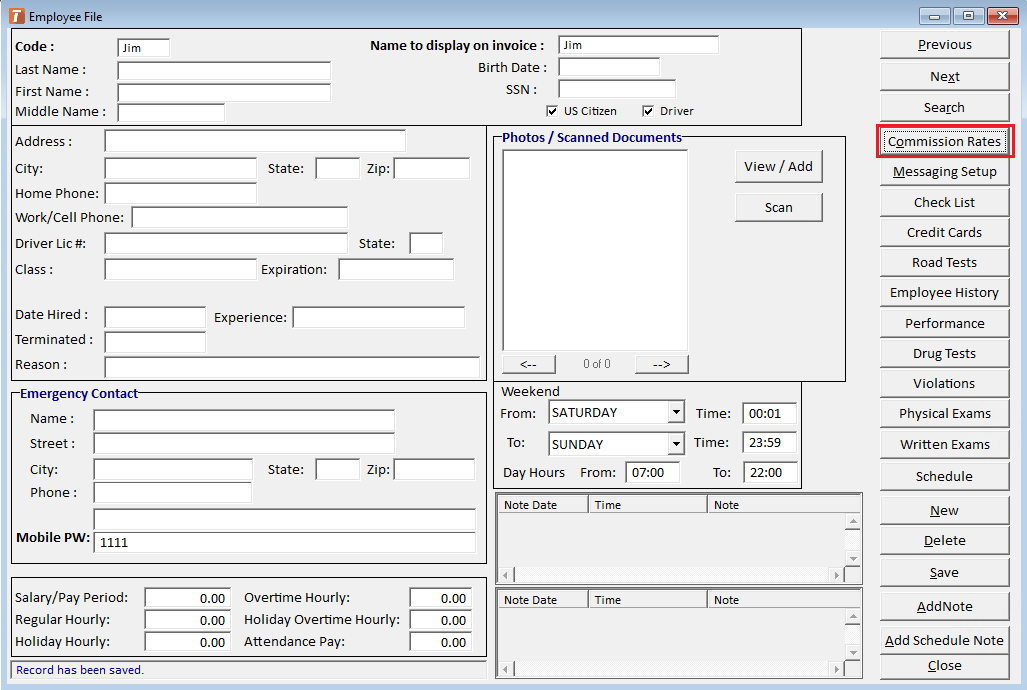
This will open a blank, driver specific, Driver Commission Rate window. Here, you can create a commission rate that is unique to this driver. Note that you can still apply the global commission templates by selecting the proper rate code.
Before selecting rate code:
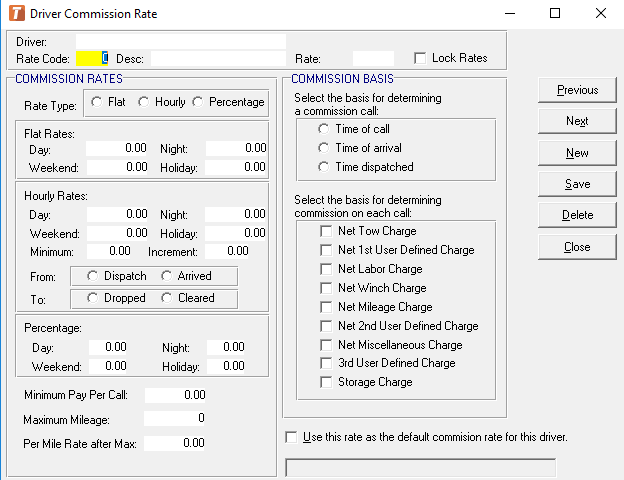
After selecting rate code:
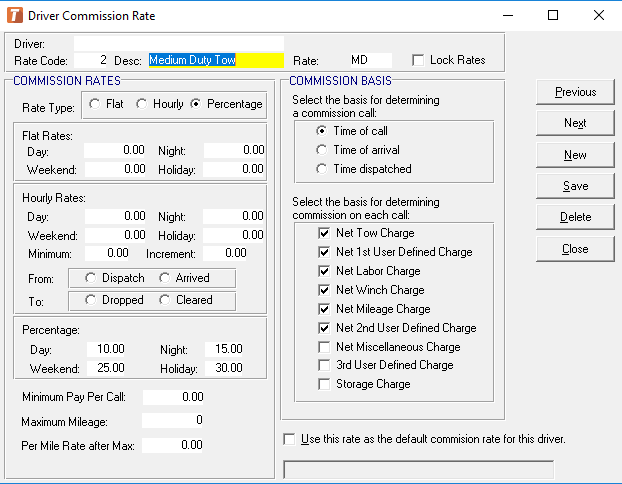
Just like with the global commission default option, you can assign a specific commission rate to a driver and check the box at the bottom of their Driver Commission Rate window. This will apply the commission, for this driver only, to all of their tows.

What if I have Global, and Driver commissions?
It is important to note that there is a system in place that chooses how commissions are prioritized.
- If a driver has a specific commission set up for a particular tow type, this commission will be chosen.
- If a driver has a commission set up in their employee profile, and the Use this Rate as default box is checked, this commission will be chosen.
- If there are not any driver specific commission settings, the global commission for that tow type will be chosen.
On the Ticket
When the tow has been completed, and the commission is ready to be applied, be sure to check the Pay Commission box at the end of the ticket. The commission details window is where you can verify the correct commission is being applied for this driver.

Within the commission details window, you can also select the Adjust button. This is where you can add a flat amount to the drivers commission, for this tow alone, on top of what they are making from the commission rates.
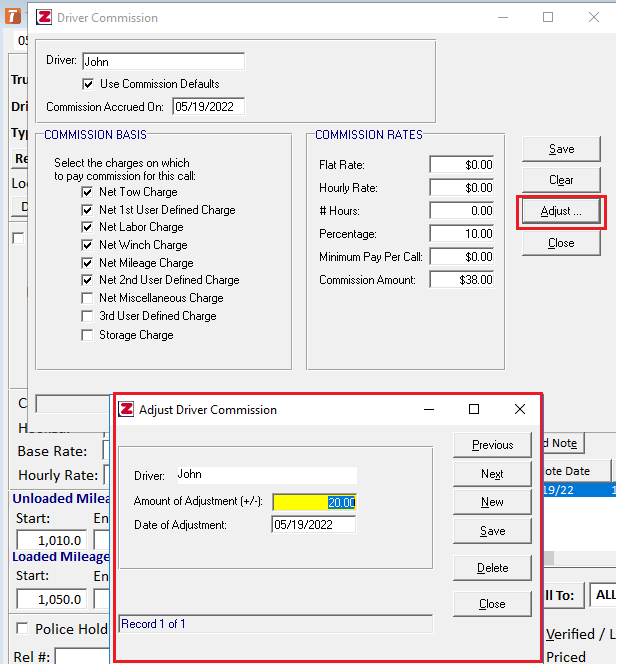
Additionally, you can also completely bypass the need to check this commission box for every ticket by navigating to Administration -> Defaults Setup -> Driver Commission and selecting the Pay Commission ON option.

Commission Reports
If you are searching for a way to track your commission expenses, then you can run several reports on it by navigating to Reports -> Other -> Driver Commission Detail / Summary / Pending.

